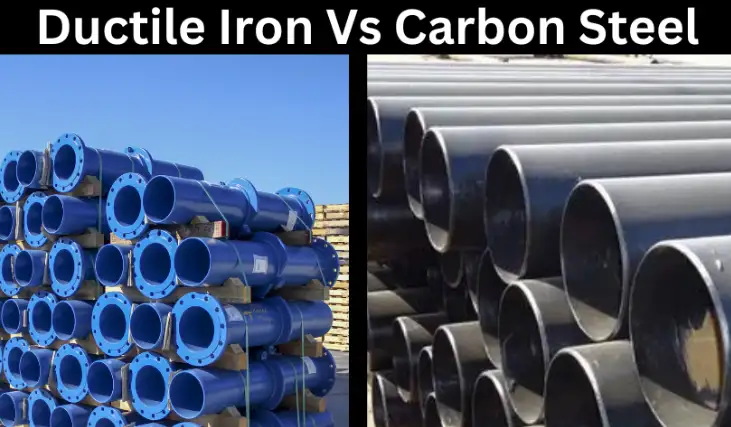Ductile iron and carbon steel are two commonly used materials in engineering and manufacturing. Both offer unique properties that make them suitable for different applications. Understanding their differences is crucial for making informed material selection decisions.

Material Composition and Microstructure
Ductile Iron:
-
Carbon Content: Typically between 3.0% and 3.9%.
-
Microstructure: Contains spheroidal graphite nodules, which enhance ductility and impact resistance.
-
Alloying Elements: May include silicon, manganese, and magnesium to achieve desired properties.
Carbon Steel:
-
Carbon Content: Generally below 2%.
-
Microstructure: Composed primarily of ferrite and pearlite, providing strength and hardness.
-
Alloying Elements: May include manganese and other elements to improve mechanical properties.
Mechanical Properties Comparison
| Property | Ductile Iron | Carbon Steel |
|---|---|---|
| Yield Strength | Up to 40 ksi | Up to 36 ksi |
| Tensile Strength | Lower than steel | Higher than ductile iron |
| Ductility | Excellent | Good |
| Toughness | High | Moderate |
| Modulus of Elasticity | Lower than steel | Higher than ductile iron |
Corrosion Resistance
-
Ductile Iron: Forms a protective oxide layer, offering superior corrosion resistance, especially in moist or marine environments.
-
Carbon Steel: More susceptible to corrosion; often requires coatings like galvanization or paint to enhance resistance.
Wear and Abrasion Resistance
-
Ductile Iron: Superior abrasion resistance due to its microstructure, making it ideal for applications like engine components.
-
Carbon Steel: Offers good wear resistance but may not perform as well as ductile iron in abrasive environments.
Manufacturing and Fabrication
-
Ductile Iron: Easier to cast with complex shapes; however, welding requires specialized procedures.
-
Carbon Steel: Easier to weld and fabricate; suitable for high-temperature applications.
Cost Analysis
-
Ductile Iron: Generally more cost-effective due to lower material and processing costs.
-
Carbon Steel: Can be more expensive, especially when considering the need for additional coatings or treatments.
Environmental Impact and Sustainability
-
Ductile Iron: Often produced from recycled materials and is recyclable, contributing to sustainability efforts.
-
Carbon Steel: Also recyclable; however, the production process may have a higher environmental impact due to energy consumption.
Applications in Industry
Ductile Iron:
-
Water and wastewater pipes
-
Automotive components (e.g., crankshafts, gears)
-
Heavy machinery parts
Carbon Steel:
-
Structural beams and columns
-
Bridges and buildings
-
Oil and gas pipelines
Selection Criteria for Engineers
When choosing between ductile iron and carbon steel, consider the following factors:
-
Mechanical Requirements: Assess the strength, ductility, and toughness needed for the application.
-
Environmental Conditions: Consider exposure to corrosive elements and the need for protective coatings.
-
Fabrication Needs: Determine the ease of manufacturing and welding requirements.
-
Cost Constraints: Evaluate material and processing costs within budget limits.
Frequently Asked Questions (FAQs)
1. What is the primary difference between ductile iron and carbon steel?
The main difference lies in their carbon content and microstructure. Ductile iron contains 3.0% to 3.9% carbon and features spheroidal graphite nodules, enhancing its ductility and impact resistance. Carbon steel has a lower carbon content (below 2%) and is composed mainly of ferrite and pearlite, providing strength and hardness.
2. Which material offers better corrosion resistance?
Ductile iron generally offers superior corrosion resistance due to its ability to form a protective oxide layer, making it ideal for applications in moist or marine environments. Carbon steel is more susceptible to corrosion and typically requires additional coatings or treatments to enhance its resistance.
3. Can ductile iron replace carbon steel in structural applications?
While ductile iron offers excellent strength and impact resistance, it may not be suitable for all structural applications. Carbon steel is preferred for high-stress applications like bridges and buildings due to its higher tensile strength and ductility. The choice depends on the specific requirements of the application.
4. How does the cost of ductile iron compare to carbon steel?
Ductile iron is generally more cost-effective than carbon steel. The lower material and processing costs contribute to its affordability, making it a preferred choice for many applications. Carbon steel can be more expensive, especially when considering the need for additional coatings or treatments.
5. Is ductile iron easier to fabricate than carbon steel?
Ductile iron is easier to cast into complex shapes, which can simplify manufacturing processes. However, welding ductile iron requires specialized procedures. Carbon steel is easier to weld and fabricate, making it suitable for applications that require high-temperature resistance and complex welding.
6. What are the environmental impacts of ductile iron and carbon steel?
Both materials are recyclable, contributing to sustainability efforts. Ductile iron is often produced from recycled materials and is recyclable, making it an environmentally friendly choice. Carbon steel is also recyclable; however, its production process may have a higher environmental impact due to energy consumption.
